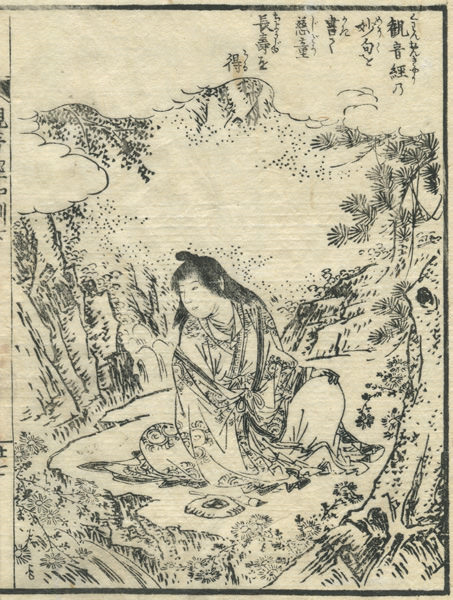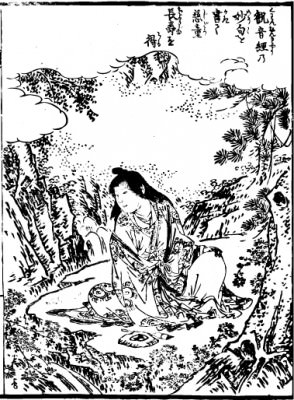“It is an illustration about description of the portion “具一切功徳慈眼視衆生福聚海無量是故応頂礼(Guittsaikudoku-jigenjisyujyou–fukufyukaimuryou-zekooutyourai).”
The title of an illustration is “write the phrase of the Sutra of Avalokitesvara and 慈童(Jidou) obtains a long life.”
The following is the free translation of an illustration portion.
“those who is called Jidou were in the time of 穆王 (Bakuou) which is a circumferential king a long time ago.
A king’s pillow will be straddled by mistake.
The person around a king will discuss and it will judge the crime to be a death penalty.
Since Bakuou was loving Jidou, the thought death penalty was stopped piteously.
and it decided for Nanyo Prefecture to 徹縣山(Tettkeizan), to obtain and to expel to a distant place. ”
“in the separation case, Bakuou teaches “慈眼視衆生福聚海無量” which is one suitable sentence out of 普門品(Fumonbon) received from the Buddha to Jidou.
Jidou keeps this phrase in a breast carefully, and leaves it. ”
“It was very sweet, when the received phrase was written to the leaf of a chrysanthemum a trip and the dew of the leaf was drunk.
It did not become hungry even if it did not eat rice etc.
And it was alive, even if it became a 彭祖仙人(Houso-sennin) at last and exceeded 700 years old.
The drop of the leaf of a chrysanthemum which described the phrase dripped to the river, and downstream people acquired the life exceeding 100 years old.
Houso-sennin is called 菊慈童(Kikujidou) in the world. ”
“This historical fact is called oral communication of the Kikusui prolongation of life.
It is a wonderful example expressing the miracle of the Sutra of Avalokitesvara. ”
The figure which will be useful 700 years or more and is useful in a still more youthful figure is drawn on the illustration.
Probably, the flower of a chrysanthemum is drawn on the circumference.
As a historical fact which tells the power of the Kannon, it is an effective tale.
「具一切功徳慈眼視衆生福聚海無量是故応頂礼」という部分の解説に関する挿絵です。挿絵のタイトルは「観音経の妙句を書きて 慈童長寿を得る」です。以下が、挿絵部分の意訳です。
「昔、周の王である穆王(ぼくおう)の時代に、慈童という者がいた。間違って王の枕をまたいでしまう。王の周囲の者が話し合い、その罪を死罪と判断してしまう。穆王は慈童をかわいがっていたので、不憫に思い死罪を止めた。そして、南陽県の徹縣山(てっけいざん)おちう遠い所に放逐することにした。」
「別れ際に、穆王は釈尊から授かった普門品(ふもんぼん)の中からふさわしい一文である「慈眼視衆生福聚海無量」を慈童に教える。慈童はこの句を大事に胸にしまって旅立つ。」
「道中、授かった句を菊の葉に書いて、その葉の露を呑むととても甘くなっていた。米などを食べなくとも、空腹にはならなかった。そして、ついに彭祖(ほうそ)仙人となって700歳を超えても生きていた。句を記した菊の葉のしずくが川にしたたり、下流の人々は100歳を超える寿命を得た。世間で菊慈童といわれているのは、彭祖仙のことだ。」
「この故事を、菊水延命の口伝という。観音経の奇跡を体現した素晴らしい事例だ。」
挿絵には、700年以上も生きてなお、若々しい姿で生きる姿が描かれています。周囲に描かれているのは恐らく菊の花でしょう。観音の力を伝える故事として、効果のある物語ですね。

